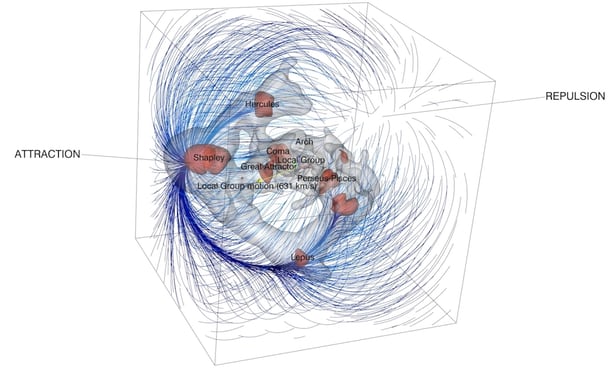Enormous extragalactic void is pushing on the Milky Way

Astronomers have discovered a vast, extragalactic void they call the Dipole Repeller, that appears to be pushing our Local G
The Milky Way galaxy is currently racing through space at about 2 million km/h (1.2 million mph), on a journey towards a gravitational anomaly known as the Great Attractor, which is in turn being dragged towards an even bigger structure, the Shapley Supercluster. But there's more to the story than these mysterious monsters: Astronomers have now discovered a huge extragalactic void, called the Dipole Repeller, that's pushing us away.
The area of space where these attractors lie is hard to observe from our vantage point here on Earth. Our Solar System sits in one of the outer spiral arms of the Milky Way, on the opposite side to the Great Attractor and Shapley Supercluster. That means that when we're looking in that direction, we first have to peer through the stars and dust of our home galaxy, and in doing so last year, an international team of researchers discovered over 800 new galaxies in that part of the sky.
The Shapley Supercluster, some 650 million light-years away, is dense with mass and is constantly drawing more mass into it, including the entire Laniakea Supercluster of galaxies that contains the Milky Way. But the pulling of matter towards concentrated areas is only part of the equation. Scientists have previously proposed that a low density region might be pushing matter away at the same time, but until now, it hadn't been found.
Since it's difficult to observe an absence of galaxies, a team of researchers from the Hebrew University of Jerusalem, along with scientists in the US and France, created a 3D map of the "galaxy flow field" – essentially, tracking the paths that galaxies are taking on their journey through the universe. Building this map using data from telescopes like Hubble, the team focused on galaxies with peculiar velocities, which means they're moving faster than the universe is expanding. Through statistical analysis of several different datasets, the team was able to infer the underlying distribution of mass throughout the universe. The model is made up of under-dense regions of dark matter that repel mass, and over-dense regions of luminous galaxies that attract it.

Researchers identified the Dipole Repeller by creating a 3D map of galaxy flows that represents an area of space measuring 1.7 billion light years across(Credit: Daniel Pomarède/ Hebrew University of Jerusalem)
Using this model, the researchers were able to identify what they call the Dipole Repeller, a large region of space that's mostly devoid of galaxies, which is repelling our galactic Local Group.
"By 3D-mapping the flow of galaxies through space, we found that our Milky Way galaxy is speeding away from a large, previously unidentified region of low density," says Yehuda Hoffman, lead researcher on the study. "Because it repels rather than attracts, we call this region the Dipole Repeller. In addition to being pulled towards the known Shapley Concentration, we are also being pushed away from the newly discovered Dipole Repeller. Thus it has become apparent that push and pull are of comparable importance at our location."
The Dipole Repeller isn't completely empty, but it has a relatively low number of galaxies. In the future, the researchers say that these galaxies could be studied and properly identified in optical, near-infrared and radio wavelengths.
The research was published in the journal Nature Astronomy.
The team describes the Dipole Repeller in the video below.
Source: Hebrew University of Jerusalem
